Baking bagels and rye bread from scratch, oh my!
- First in a 2-part post on the cookbook, “Secrets of a Jewish Baker: Recipes for 125 Breads from Around the World” by George Greenstein
I’m on a toot. I get like this every once in a while. I read a book by an author that is new to me and I have to read everything they ever wrote. I see a knitting pattern or yarn I like for a pair of socks and I am knitting socks for the next 6 months. You get the picture?
So when Holly Jennings, creator of the on-line Dowdy Corners Cookbook Club, of which I am a member, offered up “Secrets of a Jewish Baker: Recipes for 125 Breads from Around the World,”by George Greenstein, 10 Speed Press, Revised Edition 2007, as the next selection to work from, I was thrilled!
This would be a real opportunity to learn how to make the breads I loved and grew up on:seeded ryes, pumpernickel loaves, bagels, bialys, bulky and onion rolls. These yeasted Eastern European breads were the domain of Jewish bakeries and no one I knew ever baked them.
“Secrets of a Jewish Baker” covers a wide variety of breads. In fact most of the recipes are not for Jewish style breads. Greenstein, happens to be Jewish and owned a Jewish bakery on Long Island. He has written a book that imparts his knowledge, tips and tricks as a third generation professional baker, to the home baker.
The first 2 chapters are about materials and techniques. I wanted to learn how to make my favorites along with the dark health breads I had come to love after spending time in Berlin, Germany. So I focused on the Sour dough and Rolls chapters.It is critical to read the recipes you plan on making before setting out. You will need special flours (clear flour, rye and pumpernickel) and other ingredients not usually found in your cupboard such as malt syrup, rye chops and caramel color or in standard supermarkets. I was able to get many items in Whole Foods, but I still needed to shop on the King Arthur Flour website for some items. Greenstein does give you alternatives, but I suggest using the right ingredients the first time.
Well in order to make rye bread, you have to have a rye sour. Uh oh. Already I am in over my head. A rye sour is a starter, a fermented mixture which gives the bread a distinctive flavor and helps with leavening. I had never made a starter from scratch but I was committed to giving this a go. I was as interested in the process as producing a good result. Besides, rye flour,a smidge of yeast, a teaspoon of minced onion and caraway seeds, I also needed time; at least 48 hours before the sour was even ready to go into a recipe. No problem.
I also needed help to interpret the instructions in the sour recipe. It wasn’t that they weren’t clear; they were unfamiliar. Besides being the founder of the Dowdy Corners Cookbook Club, Holly Jennings is my friend and a fine editor. She edited my first cookbook, “The Korean Table,” when she worked at Tuttle Publishing. Holly needed to do research for an article on muffins she was writing for The Boston Globe, so she came to stay with me in Lexington and in addition to her research we spent several days making starters and bagels together. Two heads and hands were much better than one.
MAKING THE RYE SOUR
First we made the starter, as we would be waiting 24 hours for the fermentation to begin. As I write this, I have just made my 5th batch of Russian Health bread with the original starter. It worked!
We crushed caraway seeds and added it to a a mixture of rye flour, water, a smidge of yeast and a little grated onion.
We transferred the mixture to a larger bowl. Now began the next 3 stages. Each stage required an addition of rye flour and water. A small amount of the total flour is not mixed in but sprinkled on top of the mixture. The bowl is covered set it aside for about 4 – 8 hours ” until the floured top appears cracked with wide fissures.
- IT’S Alive! The rye sour has fissures! Greenstein’s directions and visual markers were spot on! This step was repeated 2 more times.
- The third time you remove about 1/2 cup of the sour and place it in a container in the fridge. This is the pro-genitor of all subsequent sours you will use to make additional sours. And each time you make a new sour, you are always putting some away for the next time. The starter needs to be “fed” a little flour and water every few days to keep it viable.
The rye sour is ready to make breads! There is a strong smell of rye and fermentation.
First up a seeded rye.
Special flour, called clear flour is used in many ryes. It is less refined and low in gluten. You can use regular white flour, but says Greenstein,”It won’t taste as good.” I used clear flour. The dough is kneaded, rests for 15 minutes, shaped and set aside rise until double in bulk.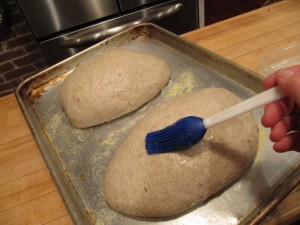
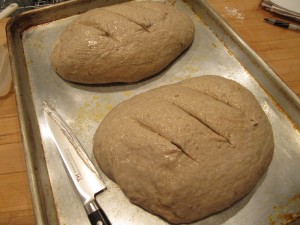
- Brush the rye bread with a cornstarch and water paste glaze. Make 3 diagonal slashes. Bake at 375 degrees.
- Rye bread!
Dense interior with a crunchy crust. Outstanding toast. Can’t believe I made that!
The other bread is a commercial rye bread, from a Jewish bakery no less!
Russian Health Bread
If you like those square dense, almost black German health bread loaves, you will surely love this bread. Greenstein calls this Russian Health Bread and it is also made with the rye sour. It includes rye chops (chopped up rye berries) and pumpernickel flour.
It’s a feisty little dough that takes a bit of strength to knead.
But it eventually behaves and forms a heavy smooth ball that rises until double in bulk.
Then cut into four pieces with 2 pieces each set into a loaf pan. And set to rise again.
Just before baking you send your finger from the center to the bottom of the loaf. I have no idea why.
This has everything I look for in a bread: it is dense, moist, toothsome and has a tang. Love it with the the wonderful veggie cream cheese Greenstein has in the book made with diced radishes, green onions, celery and shredded carrots.
- Stay tuned for Holly and Deb’s bagel bonanza!

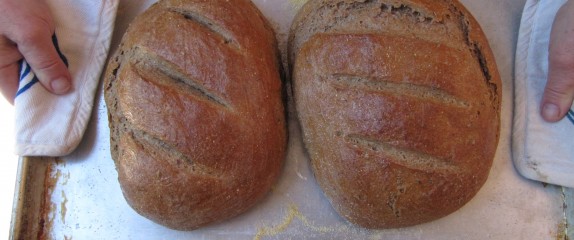
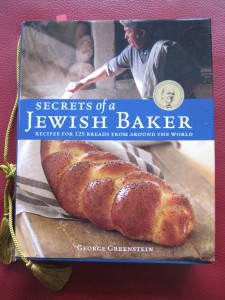
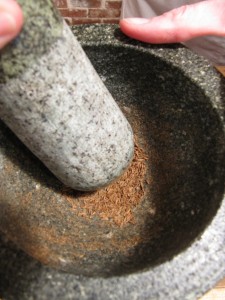
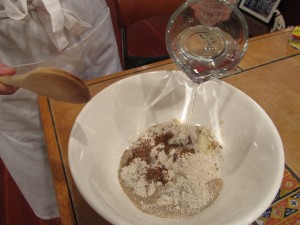
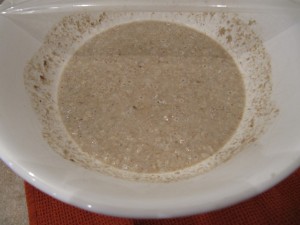
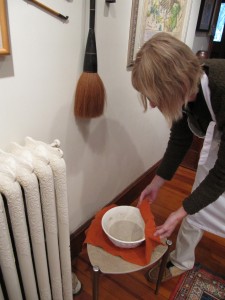
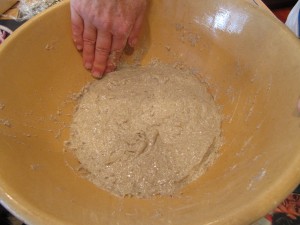
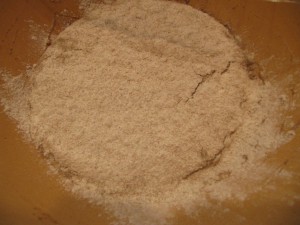
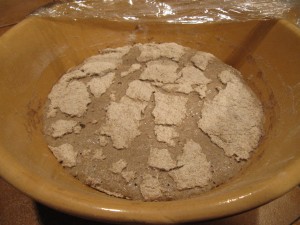
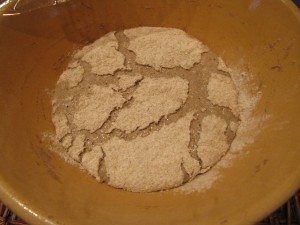
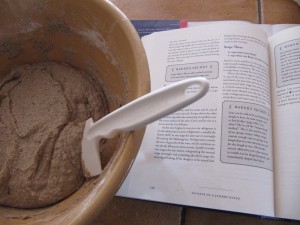
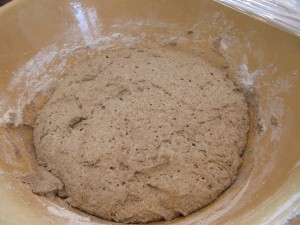
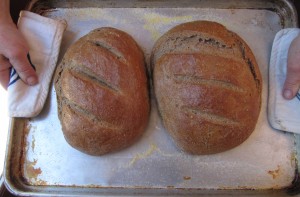
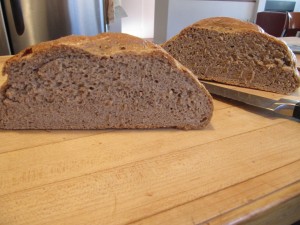
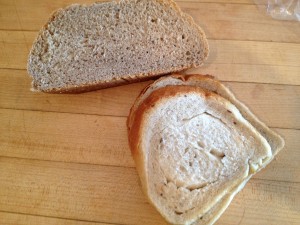
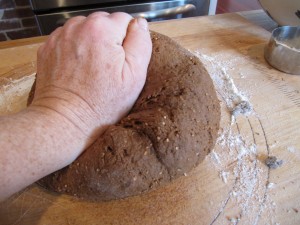
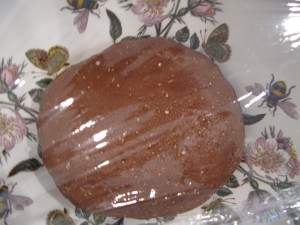
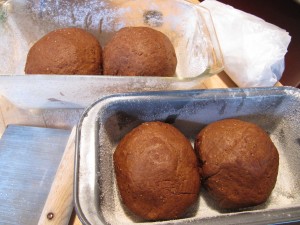
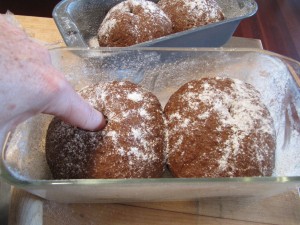
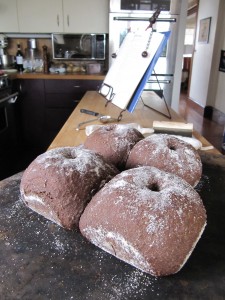









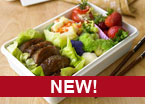 Debra Samuels, bestselling author, food writer and cooking instructor,
Debra Samuels, bestselling author, food writer and cooking instructor, 



Pingback: Dowdy Corners Cookbook ClubBaking in Boston | Dowdy Corners Cookbook Club
Gorgeous! The joy of baking bread is truly under appreciated by most. The highlight of my holiday season, besides a houseful of family, is baking Pullha, a Finnish cardamom braided bread. Happy New Year, dear friend. nha
NANCY!! Sorry I didn’t see this post before! Thanks for the comment and do you recognize the gorgeous bowl.
I use it all the time and think of you. Many many thanks.
I will get in touch through email. Cheers,Deb
Pingback: Dowdy Corners Cookbook ClubBaking with George Greenstein | Dowdy Corners Cookbook Club